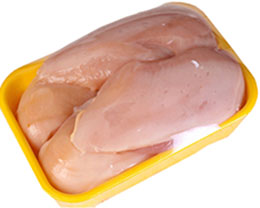Modified atmosphere packaging application - raw poultry packaging
Modified Atmosphere Packaging Application - Raw poultry Packaging
Post Time: 28 September 2020
Microbial growth, particularly growth of Pseudomonas and Achromobacter species, is the major factor limiting the shelf life of raw poultry. These Gram-negative aerobic spoilage bacteria are effectively inhibited by CO2. Consequently, the inclusion of CO2 in MAP at a concentration in excess of 20% can significantly extend the shelf life of raw poultry products. CO2 concentrations higher than 35% in the gas mixture of retail packs are not recommended because of the risks of pack collapse and excessive drip. Nitrogen is used as an inert filler gas, and a gas/product ratio of 2:1 is recommended. Since pack collapse is not a problem for bulk MAP master packs, gas atmospheres of 100% CO2 are frequently used.
Since poultry meat provides a good medium for the growth of pathogenic microorganisms, including some that are not inhibited by CO2, it is critical that recommended chilled temperatures and good hygiene and handling practices throughout the supply chain are adhered to and that products are properly cooked prior to consumption.
Early research into gas mixes for MAP of poultry meat reported discoloration of the meat at CO2 concentrations higher than 25%. Even at 15%, the authors sometimes observed a loss of bloom (Ogilvy & Ayres, 1951). This research is at variance with the lack of problems reported from the commercial use of relatively high levels of CO2 with meat products, with up to 100% in some products. Gas compositions of 25–50% CO2 and 50–75% N2 are used routinely. It would appear that the problems that have been occasionally encountered with high levels of CO2, e.g. development of greyish tinges on meat, may simply be due to high residual levels of O2 rather than the concentration of CO2 (Gill, 1990).
It is recommended that research into the optimal gas composition and package type and size should be conducted for individual food products. Furthermore, headspace gas composition will change during storage due to microbial respiration and gas exchange between the pack headspace and the environment. Therefore, processors should conduct trials to determine the extent to which gas composition changes through the shelf life of the product. The ratio of headspace pack volume to food product volume is also important, as is the types and thickness of the package material and the package design. Shelf life evaluations must reflect the conditions from manufacture to consumption of the product. It may also be necessary to consider the effect of pack opening on the subsequent shelf life of the product.
[SECTION B MAIN FOOD TYPES, Michael Mullan and Derek McDowell]
